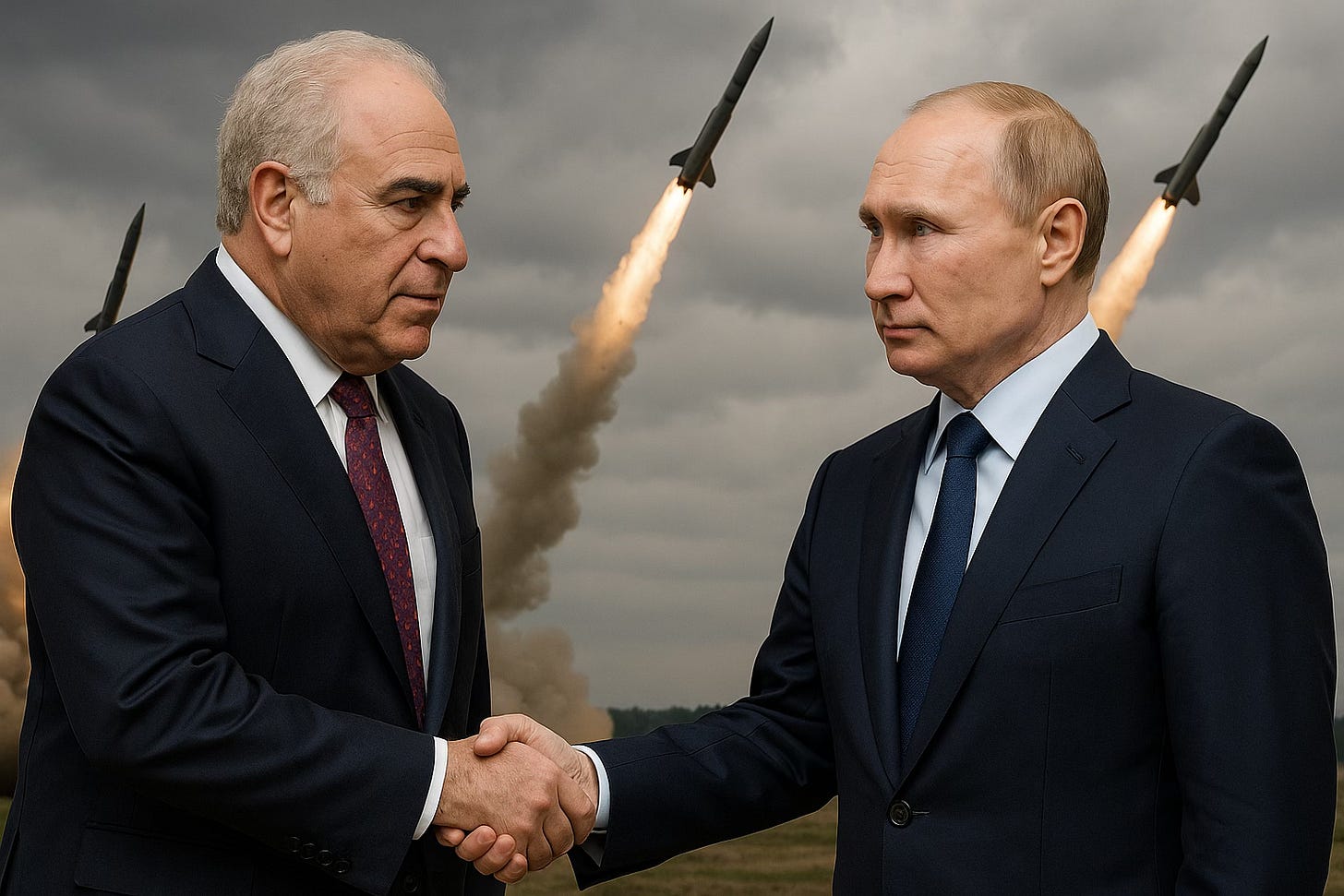The Pretend Peacemaker: Trump, Witkoff, and the Performance of Diplomacy
Trump’s false diplomacy isn’t failing; it’s working for Russia
Like most of America, I am sickened by the Trump Administration’s failure to fully support Ukraine in countering Russian attacks. Russia Trump says he wants peace in Ukraine. He says he’s disappointed in Putin. He says he’s trying to “get the killing to stop.”
But here’s what he doesn’t do: impose penalties, pressure Russia, or back Ukraine with the full power of the United States. And, day after day, we see Russia using Iranian drones to killing innocent Ukrainians in attacks on schools, hospitals, and residential buildings. Not military installations. Civilian targets.
And here’s what he does do: send a real estate developer with no diplomatic experience1 to meet privately with Vladimir Putin, while Ukrainian civilians get bombed and aid from the U.S. stalls.
Steven Witkoff has been a loyal Trump friend for decades. He isn’t a peacemaker. He’s a prop.2
What Real Power Looks Like—and What Trump Hasn’t Used
If Trump genuinely wanted to stop Russia’s aggression, he has tools—lots of them. Sanctions. Asset seizures. Tariffs. Cyberwarfare. Military aid. U.N. resolutions. But rather than use them, he’s:
Let Biden-era sanctions expire 3
Slashed U.S. military and humanitarian aid to Ukraine by over 60%4
Disbanded the DOJ’s oligarch-hunting task force (KleptoCapture) 5
Weakened NATO cooperation and threatened to withdraw entirely 6
Used conditional aid as political leverage instead of deterrence 7
And when Ukraine needed weapons in the spring and early summer of 2025?
Trump paused delivery.
That is not peace-building. That is appeasement.
Enter: Witkoff the Envoy
So why send Steven Witkoff? Why entrust back-channel diplomacy with Putin to a real estate ally best known for Trump Tower deals and hotel renovations?
He doesn’t speak Russian. He’s not a diplomat. He doesn’t brief the press. His meetings have no transparency, no readouts, no agreements.
What happens after these meetings?
Russia escalates.
The Timeline That Tells the Truth
On February 7, 2025, Witkoff met with Putin in Saudi Arabia, shortly after the Trump-Putin phone call that initiated peace negotiations.8 Six Days later, on March 3, Trump announced a suspension of all U.S. military aid to Ukraine, following a contentious Oval Meeting with President Zelensky in which he blamed the Ukrainian leader for starting and continuing the war. 9 By March 5, intelligence sharing was halted as well. 10
On April 11, 2025, Witkoff returned to Moscow for a meeting that Putin that the Kremlin described as “productive." 11 That same month, Russia launched an assault on Kharkiv including mechanized assaults and artillery. 12
In June, 2025, Witkoff met again with senior Russian officials, while Trump extended key sanctions, but he took no action to target new individuals or entities, even as Russian continued advancing and capturing key villages. 13
Visualize it:
Every time Witkoff meets with Putin or Lavrov, Russia grows bolder.
Every time Trump pauses aid or blocks sanctions, Ukraine grows more vulnerable.
And every time Trump claims he wants peace, he does nothing that would pressure the man launching the missiles.
There is a pattern. And it’s not one that ends with peace.
Voting with Russia at the U.N.
On February 24, 2025, the third anniversary of Russia’s full-scale invasion - the United Nations General Assembly voted on a resolution condemning Moscow’s continued assault on Ukraine.
Ninety-three nations supported the resolution. The Trump administration voted against it—joining only Russia, Belarus, North Korea, and Syria.
This wasn’t a slip. In the U.N. Security Council, Trump’s diplomats backed watered-down proposals that omitted language blaming Russia or affirming Ukraine’s sovereignty. These votes were not neutral—they were aligned with Moscow.
This is not diplomacy. It’s protection.
So What Is the Goal?
If this isn’t diplomacy, what is it?
We can speculate:
It’s all for show. Trump wants the optics of peacemaking without doing anything that would anger Putin—or help Ukraine.
Witkoff is delivering a message. Not a threat—but a reassurance: “Don’t worry, we won’t escalate. Just stall, and the West will fracture.”
Trump is being used. And he doesn’t mind. He’s long admired strongmen, and Putin’s war helps weaken Europe, the U.S. foreign policy establishment, and the Democratic opposition.
Russia helped him win before. U.S. intelligence agencies concluded that Russia interfered in both the 2016 and 2020 elections to help Trump. That kind of help breeds loyalty - or obligation. 14
Or worse: The failure is intentional. A slow-bleeding Ukraine makes room for Trump’s favorite narrative: that NATO is broken, Biden was reckless, and only Trump can end it - on Putin’s terms.
The Kompromat Question
And then there’s the question no one wants to ask—but that won’t go away:
What if Putin has something on Trump?
It remains unproven. But Trump’s behavior fits the pattern.
He pursued secret business deals in Russia during the 2016 campaign, including Trump Tower Moscow. 15
He has never released his full tax returns—raising questions about foreign entanglements. 16
He held multiple private meetings with Putin without American aides or translators, even seizing interpreter notes. 17
And in 2018, at the Helsinki summit, Trump publicly sided with Putin over U.S. intelligence agencies. 18
We don’t know what, if anything, Putin is holding over Trump. But we do know this:
Trump behaves as if he’s compromised—even if no one can prove it.
Theater of Negotiation
Trump is not negotiating peace. He’s rehearsing dominance. He is not stopping the war; he is stretching it, distracting from it, and selling the illusion of control while Ukraine burns.
Steven Witkoff may not speak for America. But he speaks for Trump. And right now, he’s shaking hands with Russia while the bombs fall behind him.
Footnotes:


